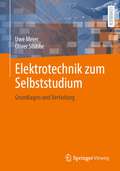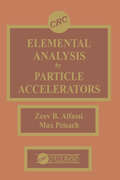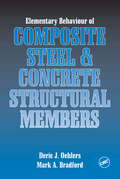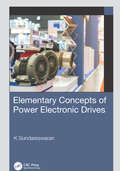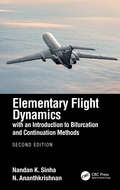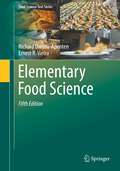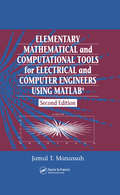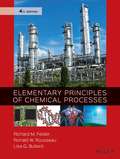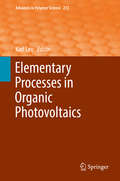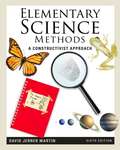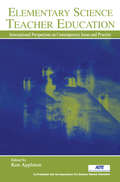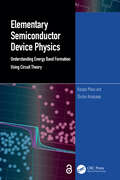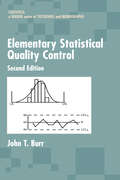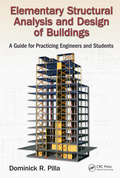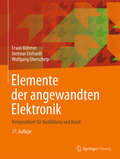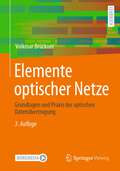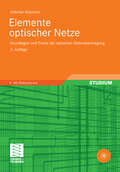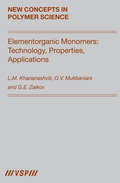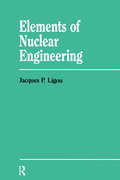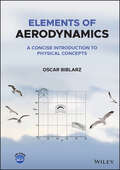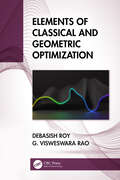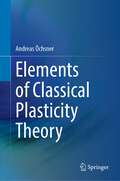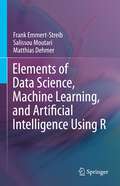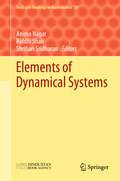- Table View
- List View
Elektrotechnik zum Selbststudium: Grundlagen und Vertiefung
by Uwe Meier Oliver StübbeDas Lehr- und Arbeitsbuch entspricht der Einführungsvorlesung der Elektrotechnik an Hochschulen und ist explizit für das Selbststudium konzipiert.Von den physikalischen Grundlagen, elektrotechnischen Grundbegriffen und elektromagnetischen Feldern bis hin zu Fourier-Reihen und transienten Vorgängen werden in 22 Kapiteln grundlegende und vertiefende Vorlesungsinhalte der Elektrotechnik wiedergegeben. Aufgaben, Lösungen und kleinere Zusammenfassungen am Ende jedes Kapitels unterstützen beim selbstständigen Lernen und Erarbeiten der Inhalte.Das Buch führt als Selbststudium leicht lesbar durch die Basis der Elektrotechnik. Das Lernen mit diesem Arbeitsbuch ist in einem Bachelor-Fernstudiengang Elektrotechnik erprobt.
Elemental Analysis by Particle Accelerators
by Zeev Alfassi Max PeisachElemental Analysis by Particle Accelerators describes the theory, methodology, and applications for a wide variety of sensitive, non-destructive methods of analysis capable of both high selectivity and multielemental determinations. Specific methods discussed include radioactive methods, particle backscatter analysis, recoil techniques, and nuclear reaction analysis. The use of multielemental PIXE and PIGME analyses of "real world" thick samples in environmental studies, trace element applications in biology, and provenance studies in archaeology are also covered. The book is a useful reference for practicing specialists and an essential text for students.
Elementary Behaviour of Composite Steel and Concrete Structural Members
by Deric J. Oehlers Mark A. BradfordThis book is aimed at developing the elementary analysis skills, familiarity and intuitive feel for composite construction that is required by undergraduate and graduate students, and by structural engineers. It does not require a prior knowledge of advanced analysis and design techniques, but builds on simple concepts such as statics and the mechanics of materials. A topic is first introduced by a brief description, with numerous carefully-chosen examples forming an integral part of the main text. Working through the examples allows the reader to gain a full understanding of the subject, as a technique is illustrated by its application to the design of new structures, or the important area of assessing and upgrading existing structures.The techniques described for the analysis of standard structures form a basis for understanding the way composite structures work, and these techniques are applied to many non-standard forms of composite construction that are rarely covered in national standards, if at all. The book is an essential purchase for all undergraduate and postgraduate students of structural and civil engineering, as well as all practitioners.
Elementary Concepts of Power Electronic Drives
by K SundareswaranFills the gap for a concise preliminary textbook on power electronic drives, with simple illustrations and applications Presents the integration of power electronics and machines in a simple manner Discusses the principles of electric motors and power electronics in an introductory manner Discusses DC and AC drives, with an emphasis on PM drives Includes questions and homework problems with hints and case studies
Elementary Flight Dynamics with an Introduction to Bifurcation and Continuation Methods
by Nandan K. Sinha N. AnanthkrishnanElementary Flight Dynamics with an Introduction to Bifurcation and Continuation Methods, Second Edition is aimed at senior undergraduate and graduate students of aerospace and mechanical engineering. The book uses an optimal mix of physical insight and mathematical presentation to illustrate the core concepts of professional aircraft flight dynamics. An updated version of the aerodynamic model is presented with the corrected definition of rate (dynamic) derivatives, supported with examples of real-life airplanes and related data and by open-source computational tools. It introduces bifurcation and continuation methods as a tool for flight dynamic analysis. FEATURES Covers an up-to-date, corrected, ‘clean’ presentation of the elements of flight dynamics Presents a blend of theory, practice and application with real-life practical examples Provides a unique viewpoint of applied aerodynamicists and aircraft designers Introduces bifurcation and continuation methods as a tool for flight dynamics analysis Includes a computational tool with real-life examples carried throughout the chapters The book is enriched with case studies of flight dynamics of a bird’s flight, of a six-seater rigid-wing airplane from a design perspective, and airship dynamics to highlight the modal behaviour of similar-looking vehicles that are distinct from each other. Excerpts from reviews of the first edition: "Flight dynamics is a topic that can cause difficulties to aerospace engineering students. This text leads the reader gently through the material with plenty of practical examples and student exercises. As such, it is easy to follow the material and to gradually develop a deep understanding of a demanding topic. The book is ideal for undergraduate students and is a good text for graduate students."––James F. Whidborne, Cranfield University, United Kingdom "The book covers all the aspects of flight dynamics traditionally found in such texts interspersed with examples of the treatment of features of current air vehicles....In my opinion, this book covers the subject comprehensively and is a desirable reference source for undergraduates and graduates alike."––R.J. Poole, MRAeS, The Aeronautical Journal, June 2014 "The book design and the methodology of interpretation are directed to a wide range of target audience/population interested in studying the dynamics of flight. Given the scale and organization of information, the book will also be a useful tool in the analysis of flight dynamics for professionals in this field. The book is sure to appeal to anyone interested in the dynamics of flight."––Jaroslav Salga, Advances in Military Technology, June 2014
Elementary Food Science (Food Science Text Series)
by Richard Owusu-Apenten Ernest R. VieiraFollowing the success of the popular introductory text,Elementary Food Science(5th edition) coversabroad range of food science topics organized infour parts; Part (1)Interrelated food science topics, Part (2)Food safety & sanitation, Part (3)Food preservation and processing and Part (4)Handling & processing of foods. The opening two chapters discuss what food science actually is, the significanceforsociety, and the large contribution of the food industry to jobs and revenue in the USA and globally. Succeeding chapterscover food regulatory agencies, food labels, food quality and sensory evaluation, and consumer food literacy. Part (2)hastwo new chapters explaininghow microbes affect food quality,and alsofoodborne disease outbreaks; GMP is described independently and as a prerequisite for HACCP, VACCP andTACCPfood-safety management systems. Part (3) containstwo new chapters dealing with basic aspects of food processing, and the quality of dried foods. Part (4) covershandling and processing major food commodity groups (meat, dairy products, poultry and eggs, fish and shellfish, cereal grains, bakery products, fruits and vegetables, sugar confectionary). A new final chapter coversthe foodservice industry. The text highlights food science links with industry uniquelyusing the North American Industry Classification System (NAICS). Overall, the book is thoroughly modernized with over 1500 references cited in recognition of thousands of named food scientists and other professionals. The target readership remain unchanged for the current edition, i.e. Students of food science fromsenior high school, colleges or universities. Sections of the book will also appeal toadvanced readers from other disciplines with perhaps little or noprior food science experience. Additionally, readers covering the intersection of food science with culinary arts, foodservices, and nutritionor public health will find the book useful.
Elementary Mathematical and Computational Tools for Electrical and Computer Engineers Using MATLAB (Second Edition)
by Jamal T. Manassah<p>Engineers around the world depend on MATLAB for its power, usability, and outstanding graphics capabilities. Yet too often, engineering students are either left on their own to acquire the background they need to use MATLAB, or they must learn the program concurrently within an advanced course. Both of these options delay students from solving realistic design problems, especially when they do not have a text focused on applications relevant to their field and written at the appropriate level of mathematics. <p>Ideal for use as a short-course textbook and for self-study Elementary Mathematical and Computational Tools for Electrical and Computer Engineers Using MATLAB fills that gap. Accessible after just one semester of calculus, it introduces the many practical analytical and numerical tools that are essential to success both in future studies and in professional life. Sharply focused on the needs of the electrical and computer engineering communities, the text provides a wealth of relevant exercises and design problems. Changes in MATLAB's version 6.0 are included in a special addendum. <p>The lack of skills in fundamental quantitative tools can seriously impede progress in one's engineering studies or career. By working through this text, either in a lecture/lab environment or by themselves, readers will not only begin mastering MATLAB, but they will also hone their analytical and computational skills to a level that will help them to enjoy and succeed in subsequent electrical and computer engineering pursuits.</p>
Elementary Principles of Chemical Processes
by Richard M. Felder Ronald W. RousseauElementary Principles of Chemical Processes, 4th Edition prepares students to formulate and solve material and energy balances in chemical process systems and lays the foundation for subsequent courses in chemical engineering. The text provides a realistic, informative, and positive introduction to the practice of chemical engineering.
Elementary Processes in Organic Photovoltaics
by Karl LeoThis book presents the results of a multi-year research programme funded by the Deutsche Forschungsgemeinschaft, which which explain how organic solar cells work. In this new promising photovoltaic technology, carbon-based materials are deposited by low-cost methods onto flexible substrates, thus allowing devices which open completely new applications like transparent coatings for building, solar cells integrated into clothing or packages, and many more. The investigation of organic solar cells is an interdisciplinary topic, covering physics, chemistry and engineering. The different chapters address topics ranging from the synthesis of new organic materials over the characterization of the elementary processes such as exciton transport and separation to the principles of highly efficient device design.
Elementary Science Methods: A Constructivist Approach
by David Jerner MartinIn this pioneering text, a constructivist approach guides users in learning how to teach in a constructivist manner. The book is based on the belief that items more important for children to learn how to do science than it is for them to learn about science, and that teachers of elementary science do not need to know a great deal of science to teach it effectively, but rather need to be co-inquirers with their students. More than 170 process-oriented activities, organized by grade level, help practicing teachers encourage children to develop and perform their own investigations.
Elementary Science Teacher Education: International Perspectives on Contemporary Issues and Practice
by Ken AppletonCo-Published with the Association For Science Teacher Education. Reflecting recent policy and standards initiatives, emerging research agendas, and key innovations, this volume provides a contemporary overview of important developments and issues that have that have in recent years shaped elementary science education pre-service courses and professional development, and practices that are shaping future directions in the field. Contributors from several countries who are actively engaged in research and design in elementary science education address:*Conceptual issues which impinge on contemporary science teacher education;*Intersections of content, pedagogy, and practice; and*Professional development as a contextualized practice.Elementary Science Teacher Education: International Perspectives on Contemporary Issues and Practice offers a clear picture of the current state of the field and directions for the future--to the benefit of elementary science teacher educators, aspiring teacher educators, school policy makers, other professionals involved in science education and, ultimately, the millions of elementary school children who will gain from improved practice.
Elementary Semiconductor Device Physics: Understanding Energy Band Formation Using Circuit Theory
by Kazuya Masu Shuhei AmakawaThis book by two leading experts on integrated circuit design adopts an untraditional approach to introducing semiconductor devices to beginners. The authors use circuit theory to provide a digestible explanation of energy band theory and understanding of energy band diagrams. After briefly summarizing the basics of semiconductors, the authors describe semiconductor devices from a circuit theoretic point of view, making the book especially suitable for circuit design students and engineers. Further to the emphasis on the circuit perspective, the book then uses circuit theory to introduce readers to the famously indigestible “energy bands” of crystalline solids. Additionally, the book explains how to read physics from “energy band diagrams” of semiconductor devices in great detail. The key to appreciating the real power of energy band diagrams is shown to lie in the understanding of the concept of the “quasi-Fermi levels,” introduced in 1949 by William Shockley but remaining elusive to date and therefore often omitted from energy band diagrams. To rectify this, some of the energy band diagrams presented in this book, complete with quasi-Fermi levels, were drawn using a device simulator (a.k.a. technology computer-aided design; TCAD), offering quantitative information about device physics. The book could, therefore, also serve as a hands-on course text in TCAD-drawn band diagram reading.Because no prior exposure to quantum mechanics is required and the book does not attempt to teach it, this book is ideal for students in various disciplines who may or may not be specializing in semiconductor devices. The numerous practical examples of reading TCAD-based energy-band diagrams are also invaluable to practicing semiconductor device engineers.
Elementary Statistical Quality Control (Statistics: A Series of Textbooks and Monographs)
by John T. BurrMaintaining the reader-friendly features of its popular predecessor, the Second Edition illustrates fundamental principles and practices in statistical quality control for improved quality, reliability, and productivity in the management of production processes and industrial and business operations. Presenting key concepts of statistical quality c
Elementary Structural Analysis and Design of Buildings: A Guide for Practicing Engineers and Students
by Dominick R. PillaThis overview of the analysis and design of buildings runs from basic principles and elementary structural analysis to the selection of structural systems and materials, and on to foundations and retaining structures. It presents a variety of approaches and methodologies while featuring realistic design examples. <P><P> As a comprehensive guide and desk reference for practicing structural and civil engineers, and for engineering students, it draws on the author’s teaching experience at The City College of New York and his work as a design engineer and architect. It is especially useful for those taking the National Council of Examiners for Engineering and Surveying SE exam.
Elemente der angewandten Elektronik: Kompendium Für Ausbildung Und Beruf (Viewegs Fachbücher Der Technik Ser.)
by Erwin Böhmer Dietmar Ehrhardt Wolfgang OberschelpDas zu Grunde liegende erfolgreiche didaktische Konzept wird beibehalten. Mit seinem besonderen Aufbau, der Behandlung von Themen auf jeweils einer Text- und einer Bildseite, ist das Buch durchgängig und übersichtlich gestaltet. Die einzelnen Gebiete sind in sich geschlossen behandelt und lassen sich für unterschiedliche Lehrveranstaltungen sowie autodidaktisch verwenden. Mit seinen zahlreichen Beispielen vermittelt das Buch zwischen Theorie und Praxis. Es ist ein zuverlässiger Begleiter für das Elektronikpraktikum und darüber hinaus Arbeitsgrundlage für Schaltungsentwickler. Diese 17. Auflage ...
Elemente optischer Netze: Grundlagen und Praxis der optischen Datenübertragung
by Volkmar BrücknerIn diesem einführenden und kompakten Lehrbuch werden die wichtigsten Elemente von optischen Netzen eingeführt und für die ingenieurmäßige Lösung praktischer Probleme aufbereitet. Thematische Schwerpunkte sind Glas- und Polymerfasern, optische Sender und Empfänger, die Modulation von Laserlicht für hochbitratige Übertragungen, Elemente passiver (Koppler, Verzweiger) und aktiver (Schalter, optische Verstärker) Netze und der Einfluss nichtlinearer Effekte auf die optische Datenübertragung. An Beispielen werden Vorteile und Grenzen der Datenübertragung in optischen Netzen erläutert. Zu jedem Schwerpunkt werden praxisnahe bzw. praxisorientierte Fragen und Aufgaben gestellt. Schwierige mathematische Zusammenhänge und Formeln werden nachvollziehbar in MathCad® simuliert.
Elemente optischer Netze: Grundlagen und Praxis der optischen Datenübertragung
by Volkmar BrücknerIn diesem einführenden und kompakten Lehrbuch werden die wichtigsten Elemente von optischen Netzen eingeführt und für die ingenieurmäßige Lösung praktischer Probleme aufbereitet. Thematische Schwerpunkte sind Glas- und Polymerfasern, optische Sender und Empfänger, die Modulation von Laserlicht für hochbitratige Übertragungen, Elemente passiver (Koppler, Verzweiger) und aktiver (Schalter, optische Verstärker) Netze und der Einfluss nichtlinearer Effekte auf die optische Datenübertragung. An Beispielen werden Vorteile und Grenzen der Datenübertragung in optischen Netzen erläutert. Zu jedem Schwerpunkt werden praxisnahe bzw. praxisorientierte Fragen und Aufgaben gestellt. Schwierige mathematische Zusammenhänge und Formeln werden nachvollziehbar in MathCad® simuliert.
Elementorganic Monomers: Technology, Properties, Applications
by L.M. Khananashvili O.V. Mukbaniani Gennady E. ZaikovNew fields of science and technology call for new materials with valuable performance characteristics. Long-term resistance to such temperatures can be found only in polymers with chains made up of thermostable fragments. Particularly interesting in this respect are elementorganic polymers with inorganic and organo-inorganic molecular chains. Elementorganic polymers are not only highly thermostable, but also perform well under low temperatures, sunlight, humidity, weather, etc. Thus, these polymers (especially silicones) are widely and effectively used in the electrical, radio, coal, mechanical rubber, aircraft, metallurgical, textile, and other industries. They are of great utility not only in industry, but also in households and in medicine, where their merits can hardly be overestimated.The need to publish this book arose with the scientific and technical developments of the last decade, the reconstruction and technical renovation of existing factories, as well as fundamental changes in some syntheses of elementorganic monomers and polymers. Moreover, nowadays it is essential to train highly skilled chemical engineers with a comprehensive knowledge of current chemistry, of the production technology of elementorganic monomers and polymers, and of their characteristics and applications.
Elements Nuclear Engineering
by Sara Mitter Jacques P. LigouFirst Published in 1986. This work should be considered as a simple introduction to nuclear engineering. It covers and somewhat enlarges upon a set of courses that the author’s currently give at the Ecole Polytechnique Federale of Lausanne, Switzerland.
Elements of Advanced Manufacturing Theory
by Bruno G. Rüttimann Martin T. StöckliThis book is the continuation of the textbook Lean Compendium – Introduction to Modern Manufacturing Theory. It extends the theory of mathematical modeling to batch & queue-based cyber-physical production systems. To facilitate learning, the book continues to develop a Cartesian-derived understanding of the system’s behavior by applying manufacturing-specific theorems, corollaries and lemmas. A law-based description enables to model production mathematically and understand upfront their dynamics in terms of WIP generation, lead-times, exit-rates, and on-time delivery performance. While simulation alone only allows to explore the optimum solution, the development of a theory allows to gain knowledge. This improves the learning of the “physics” of manufacturing systems and contributes to a solid production’s understanding and a clear and cognitive problem determination that leads to a thorough mental capture for mastering a systematic design of such highly complex systems.
Elements of Aerodynamics: A Concise Introduction to Physical Concepts
by Oscar BiblarzELEMENTS OF AERODYNAMICS An accessible and hands-on textbook filled with chapter objectives, examples, practice problems, sample tests, and an online aero-calculator In Elements of Aerodynamics, Professor Oscar Biblarz delivers a concise and fundamentals-oriented approach to aerodynamics suitable for both undergraduate and graduate-level students. The text offers numerous problems, examples, and check tests, allowing readers to gain and cement their knowledge through hands-on practice. Using a unique blend of fundamentals, the book provides students with a new approach to high lift airfoils including examples designed to complement the theory. It covers the most vital information on incompressible and compressible flow over two-dimensional and three-dimensional wings. A companion website that includes an interactive aero-calculator and additional student resources makes this a suitable text for online, hybrid, and distance learning. Readers will also find: A concise introduction to units and notation with discussion of the proper usage of dimensionless coefficients in aerodynamics, featuring descriptions of airflow as an incompressible and compressible low-viscosity medium past streamlined wings Comprehensive re-evaluation of the fundamentals of fluid dynamics, including the differential control volume approach and formulation of lift, drag, and pitching moments for thin, attached boundary layers over slender wings at high angles of attack Practical applications of mass, momentum, and energy relations, derived from Euler’s equation, Bernoulli’s equation, and the Kutta-Joukowski theorem Selected treatment of transonic and hypersonic aerodynamic aspects, including supercritical airfoils, the non-linear small perturbation potential equation, Newtonian theory, and hypersonic lift and drag Well-suited for students enrolled in an introductory aerodynamics course as part of an engineering program, Elements of Aerodynamics will also earn a place in the libraries of physics students and those interested in basic fluid mechanics.
Elements of Classical and Geometric Optimization
by Debasish Roy G Visweswara RaoThis comprehensive textbook covers both classical and geometric aspects of optimization using methods, deterministic and stochastic, in a single volume and in a language accessible to non-mathematicians. It will help serve as an ideal study material for senior undergraduate and graduate students in the fields of civil, mechanical, aerospace, electrical, electronics, and communication engineering. The book includes: Derivative-based Methods of Optimization. Direct Search Methods of Optimization. Basics of Riemannian Differential Geometry. Geometric Methods of Optimization using Riemannian Langevin Dynamics. Stochastic Analysis on Manifolds and Geometric Optimization Methods. This textbook comprehensively treats both classical and geometric optimization methods, including deterministic and stochastic (Monte Carlo) schemes. It offers an extensive coverage of important topics including derivative-based methods, penalty function methods, method of gradient projection, evolutionary methods, geometric search using Riemannian Langevin dynamics and stochastic dynamics on manifolds. The textbook is accompanied by online resources including MATLAB codes which are uploaded on our website. The textbook is primarily written for senior undergraduate and graduate students in all applied science and engineering disciplines and can be used as a main or supplementary text for courses on classical and geometric optimization.
Elements of Classical Plasticity Theory
by Andreas ÖchsnerThis monograph provides a compact introduction into the classical, i.e. rate-independent, plasticity theory. Starting from the engineering stress-strain diagram, the concept of elastic and elasto-plastic material behavior is introduced, as well as the concept of uniaxial and multiaxial stress states. Continuum mechanical modeling in the elasto-plastic range requires, in regards to the constitutive equation, in addition to the elastic law (e.g. Hooke’s law), a yield condition, a flow rule and a hardening rule. These basic equations are thoroughly introduced and explained for one-dimensional stress states. Considering three-dimensional plasticity, different sets of stress invariants to characterize the stress matrix and the decomposition of the stress matrix in its hydrostatic and deviatoric part are introduced. Furthermore, the concept of the yield condition, flow rule and hardening rule is generalized for multiaxial stress states. Some typical yield conditions are introduced and their graphical representation in different stress spaces is discussed in detail. The book concludes with an introduction in the elasto-plastic finite element simulation of mechanical structures. In the context of numerical approximation methods, the so-called predictor-corrector methods are used to integrate the constitutive equations. This is again introduced in detail based on one-dimensional stress states and afterwards generalized to the three-dimensional case. Test your knowledge with questions and answers about the book in the Springer Nature Flashcards app.
Elements of Data Science, Machine Learning, and Artificial Intelligence Using R
by Frank Emmert-Streib Salissou Moutari Matthias DehmerThe textbook provides students with tools they need to analyze complex data using methods from data science, machine learning and artificial intelligence. The authors include both the presentation of methods along with applications using the programming language R, which is the gold standard for analyzing data. The authors cover all three main components of data science: computer science; mathematics and statistics; and domain knowledge. The book presents methods and implementations in R side-by-side, allowing the immediate practical application of the learning concepts. Furthermore, this teaches computational thinking in a natural way. The book includes exercises, case studies, Q&A and examples.
Elements of Dynamical Systems (Texts and Readings in Mathematics #79)
by Anima Nagar Riddhi Shah Shrihari SridharanThis book stems from lectures that were delivered at the three-week Advanced Instructional School on Ergodic Theory and Dynamical Systems held at the Indian Institute of Technology Delhi, from 4–23 December 2017, with the support of the National Centre for Mathematics, National Board for Higher Mathematics, Department of Atomic Energy, Government of India. The book discusses various aspects of dynamical systems. Each chapter of this book specializes in one aspect of dynamical systems and thus begins at an elementary level and goes on to cover fairly advanced material. The book helps researchers be familiar with and navigate through different parts of ergodic theory and dynamical systems.
